Read Yucatan or Zihuatanejo
San Miguel March 2015
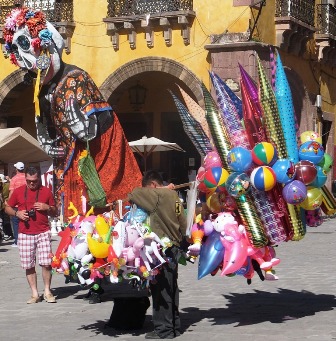
What does San Miguel de
Allende conjure up for me? Fiestas and celebrations! March was a month of Native
Cultural Festivals, Religious Festivals, Music Festivals, Film Festivals and
lots of socializing in between. If anyone tells me they were bored in San
Miguel, I would tell them they must have been asleep for the entire visit.
Ray and I arrived by
plane, via Mexico City, to Leon, where the BajioGo Shuttle was waiting to take
us to San Miguel. We shared the service with a young American couple, who had
just celebrated their wedding at a resort in Puerto Morelos, our favourite town
on the Yucatan. It was Friday night and celebrations were in progress in the
central Jardin, the formal garden and meeting place, right across the street
from the Parroquia Church, the symbol of San Miguel seen on almost all the
advertising posters. This is where most of the excitement begins in San Miguel.
We were staying in a small hotel, right on the Jardin, because the apartment we
had reserved for the next four weeks was not ready until the next day.
We checked into our room and found a small restaurant nearby to have a light supper. As soon as we had eaten, we headed back to the Jardin. A Mariachi Band was in fine form and a Bride and a Groom Gigantes, marionette-like costumes that tower twice as high over the person wearing them, strolled among the people. Several formally dressed young men were offering to fill the miniature ceramic mugs people were wearing on a ribbon around there necks with mescal from bottles carried in the saddlebags on a donkey. This was a Callejóneada, similar to the one we had experienced in Zacatecas last year. It makes a wedding into a festival. All the guests fill their cups and walk around the streets near the Parroquia church. Ray was given a mini-mug and we both toasted the bridal couple with the mescal. We spied the young American newlyweds and passed the cup to them so that they could experience a Mexican celebration.
Our apartment was near the
bottom of Conde de Canal, named for the Count of Canal, one of the most
important figures in Colonial San Miguel. It was 10 minute walk straight
downhill on the cobbled street from the Jardin (or uphill on the way to the
Jardin). Our landlord called our apartment, one of three in the building, a
Penthouse, as it had two floors and a roof top terrace. One street level
apartment had access to a backyard garden while our penthouse was one of two on
the second floor. We had a large living room, a dining room and kitchen on the
main floor, and two bedrooms, one overlooking the living room, on the third
floor. Our terrace had lots of flowering pots, two long chaises for warm
afternoon relaxing and a table and chairs for outdoor dining. We set up a
laundry line on the terrace that was perfect for quick drying our hand laundry,
washed in the sink on the terrace. We soon found our way on side streets to
hotel Posada de Aldea, where I joined an Aquafit class in the outdoor pool each
Tuesday and Thursday morning.
The next Thursday evening
was the beginning of 24 hours of performances in honor of El Señor de la
Conquista, (Lord of the Conquest) one of the city’s most venerated religious
figures. The first Friday in March each year Indigenous groups of dancers,
called ‘Concheros’, dressed in elaborate pre-Hispanic costumes, come from many
of the Catholic parishes in towns surrounding San Miguel, to dances for hours on
end around the Jardin. The origin of this festivity is a subject of debate. All
agree that it began in the late 1500’s and represents the acceptance of Christ
by Mexico's indigenous people It revolves around a life-sized replica of Jesus
Christ on the cross, fashioned of corn stalks and orchid bulbs, is brought each
year from Pátzcuaro.
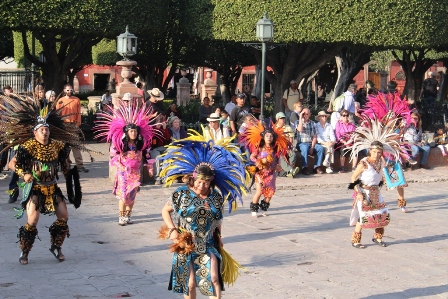 This year one group of dancers arrived at the Jardin Thursday
evening. We were there to see the dancers perform accompanied by drummers. That
was just a lead up to waves of dancers who arrived the next morning. Group after
group made their way to the streets bordering the Jardin. There were elders,
young people and children, all dressed in their finest outfits and prepared for
hours of dancing. Each group carried banners identifying their parish and each
group had their opportunity to stop and perform their most complicated dances
for the appreciative crowd. Periodically one group at a time would stop and file
into the Parroquia to recite 33 prayers, one for each year of Christ’s life. By
the afternoon many of the dancers were suffering from sore feet, but they kept
on. It was an ideal photo op. I couldn’t resist. There are several of our photos
on Picasa.
This year one group of dancers arrived at the Jardin Thursday
evening. We were there to see the dancers perform accompanied by drummers. That
was just a lead up to waves of dancers who arrived the next morning. Group after
group made their way to the streets bordering the Jardin. There were elders,
young people and children, all dressed in their finest outfits and prepared for
hours of dancing. Each group carried banners identifying their parish and each
group had their opportunity to stop and perform their most complicated dances
for the appreciative crowd. Periodically one group at a time would stop and file
into the Parroquia to recite 33 prayers, one for each year of Christ’s life. By
the afternoon many of the dancers were suffering from sore feet, but they kept
on. It was an ideal photo op. I couldn’t resist. There are several of our photos
on Picasa.
Ray and I were playing
cards back at the apartment before dinner when we heard drumming. We looked out
our front window to see the Concheros in a procession right up Canal Street,
heading for the Parroquia. The
famous the Christ figure on a cross was carried on a palanquin, followed by
several groups carrying offerings of food and special breads, all accompanied by
brass bands and of course the dancers.
The next week brought
Cubanafest. Last year there were singers and a band performing on a stage next
to the Parroquia. This year the festivities were interrupted by unusually cold
temperatures and driving rain. We did get out one night to watch dancers perform
both traditional and modern dances.
What did we do when there were not Fiestas to attend? We attended many of the cultural events scheduled for March. There were so many interesting events planned it was often difficult to make a choice. We were privileged to get tickets to four Classical concerts, part of the ProMusica series, held in St Paul’s Anglican Church. They were all excellent. As if that wasn’t enough music there were several guitar concerts in the Biblioteca, which hosts a variety of programs each week. Then there was a one-woman play at the new San Miguel Playhouse, a play-reading back at St Paul’s, and recent movies at the Pocket Theatre or in a small theatre in the Hotel Bacco. We also attended several excellent documentary films that included discussion groups on the topic or talks on a multitude of very topical subjects given by knowledgeable experts. Wow!
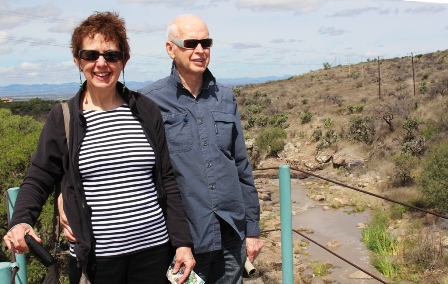 Morris Davison and
Christine Harrison came for their first visit to San Miguel. When we weren’t
attending concerts, we explored the streets of San Miguel, starting with a
guided walk of the Historic center. A visit to El Charco del Ingenio, the large
ecological park encompassing the Jardin Botanico is always worth a repeat. Each
season brings new surprises. The grounds, with their extensive walking paths,
include the original reservoir for San Miguel that also provided power for a
cotton mill. We followed the pathways through the cactus gardens and walked
along the path bordering the Cañada (a ravine, or canyon) leading to the
reservoir. Part way around we met up with a birding walk led by Bob Graham, who
was our walking tour guide a few days beforehand. He and Morris, both ex-Parks
Canada employees, found they had mutual Parks Canada friends.
Morris Davison and
Christine Harrison came for their first visit to San Miguel. When we weren’t
attending concerts, we explored the streets of San Miguel, starting with a
guided walk of the Historic center. A visit to El Charco del Ingenio, the large
ecological park encompassing the Jardin Botanico is always worth a repeat. Each
season brings new surprises. The grounds, with their extensive walking paths,
include the original reservoir for San Miguel that also provided power for a
cotton mill. We followed the pathways through the cactus gardens and walked
along the path bordering the Cañada (a ravine, or canyon) leading to the
reservoir. Part way around we met up with a birding walk led by Bob Graham, who
was our walking tour guide a few days beforehand. He and Morris, both ex-Parks
Canada employees, found they had mutual Parks Canada friends.
One highlight for all
of us was a morning spent at the Fabrica la Aurora, once a textile factory and
now a series of excellent art and design galleries and artist’s studios.
Otto Kremer and his
wife Christine Lodge, friends from Ottawa, were in San Miguel the same time as
we were. They kindly delayed their departure until after Morris and Christine
arrived so that we could share drinks at their apartment before going to one of
the best restaurants in town, La Fireze, for dinner. We all enjoyed the evening.
A recent TV news story
highlighted one woman’s attempt to get people aware that you don’t have to be a
model or a movie star to feel comfortable in your own body. San Miguel beat her
to the punch. Over the past winter photographer George Krause persuaded sixty
San Miguel residents to pose for him, nude. Double-sided life-sized photographs,
a different person on each side, hung from wires, and filled a room in the
Bellas Artes art and practise building in San Miguel. It was an amazing display
of real, mostly older, people, not air brushed beauties and not hiding from the
camera.
Our visit last year
with Suzanne and David Andrews was one of the reasons we decided to come for the
month of March this year. The
Andrews also introduced us to a group of their friends who have been coming to
San Miguel for several years We enjoyed dinners back in forth in each other’s
apartments and in various restaurants. Morris and Christine had been
disappointed in the restaurants they went to during their two night stay in
Mexico City. They were not disappointed in the fare offered in San Miguel. In
fact, despite of all the excellent meals we enjoyed, Morris reported that he
discovered he had lost three lbs during his time away. It must have been all the
extra walks Ray took them on while I was at Aquafit.
Our last week in San Miguel started with a bang, literally. Friends asked us if we were going to watch the annual Processión del Señor de la Columna (procession of our Lord of the Column). It sounded intriguing. Two Sundays before Easter, thousands of pilgrims start at midnight to carry a life sized image of Jesus, from its home in Atotonilco. The 12 km trip was expected to arrive at to San Juan de Dios, just a few blocks from our apartment in San Miguel, at 8 AM. The statue was carved in 1812 by the local parish priest in Atotonilco. The people brought the statue from Atotonilco in 1823 to San Miguel in hopes he would deliver the village from a raging cholera epidemic. Apparently it worked and the tradition has been carried on every year since that time.
During the night the route of the parade through San Miguel is decorated elaborately by various neighbourhood parishes. Carpets of flower petals, coloured wood chips and fragrant herbs, fennel, camomile and other herbs cover the pavement. Some sections are works of art, depicting religious scenes. Wires are strung above the street and hung with balloons, crepe paper flowers and other decorations. Big arches are constructed and stands holding bouquets of flowers line the streets. It is a sight to be seen. Ray woke us up about 6 AM and we walked over to the church where many people were sleeping beside the road. Food stands were starting to appear and more and more people were gathering. We walked north along the route to see the decorations. The skies echoed with exploding firecrackers, announcing that the procession was starting down long Independencia Avenue. We joined the crowd, led by young girls and boys in first communion outfits, a brass band playing dirge-like music, altar boys, a group dressed in Roman soldier outfits, carrying whips, priests and the sculptures, carried on palanquins. The Virgin Mary was carried mostly by women, while the other two figures were carried by men. The procession stopped just past the bridge at the intersection of Independencia and San Antonio Abad for a short mass, piped over loud speakers to the crowd of worshippers. We followed the procession back to San Juan de Dios church and then took our leave.
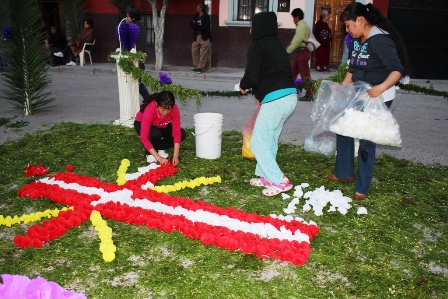 Street decorated for Our Lord of the Column |
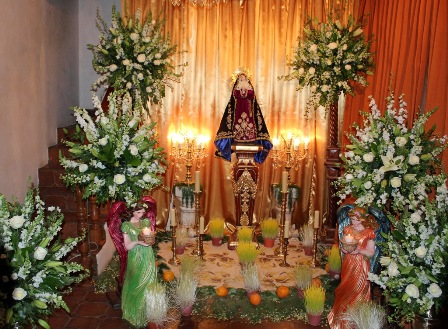 Altar for Our Lady of Sorrows |
The Friday before Good
Friday commemorates Nuestra Señora de Dolores (Our Lady of Sorrows). Altars are
built throughout San Miguel to acknowledge Mary’s seven sorrows that culminate
in her pain at losing her only child. The altars contain symbolic elements of
sorrow including sour oranges, camomile, wheat grasses and purple cloth. We had
seen one shrine built around a large fountain in the courtyard of Hotel Posada
de Aldea, where I have my Aquafit. At night candles are lit around the altars,
making it almost mystical. On the way to the Jardin where we were to meet
Suzanne and David, we passed two houses that had small shrines. Family members
were handing out drinks in plastic bags with a straw and frozen popsicles which
represent the tears of Our Lady of Sorrows. Indigenous tradition held that by
freezing tears sadness is transformed into a gift providing joy. There was a
large display in the entrance to the Parroquia and lots of people wandering
around. The corner of Hernandez Macias and Mesone, next to the Angela Peralta
Theatre, had a live enactment of Jesus carrying a wooden cross and a sorrowful
Mary standing in a niche. Nearby, an interior courtyard circled with shops had
an impressive display with a tableau on both sides of the picture of Mary, all
circled with candles. The lobby of the Angela Peralta Theatre had an unrelated
event just starting. It was an opening night of photographs taken in many parts
of the world, many of which we had visited. Glasses of wine were being handed
out and the photographer, a woman, was introduced. It made a nice break to our
altar tour.
Our last stop was the
Templo de San Francisco to see another display inside the church. By that time
the temperature had dropped and the warmth of a nearby café beckoned.
Mugs of coffee, and for me, a hot chocolate, were just what we needed.
Within a few days most
of our friends, including Ray and I, were flying back to the cold north. We had
all made arrangements to rent apartments for the next year. The month had sped
by. We look forward to next March, returning to favourite places and discovering
new ones.
Read 2015 Yucatan or Zihuatanejo
Return to Mexico Introduction
Return to Travels
Return to Introduction